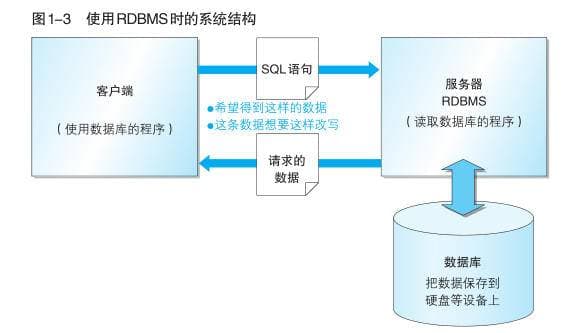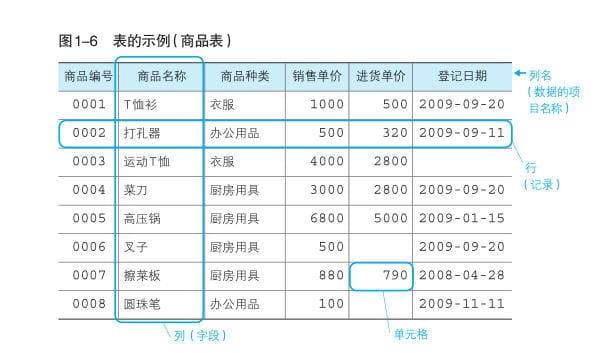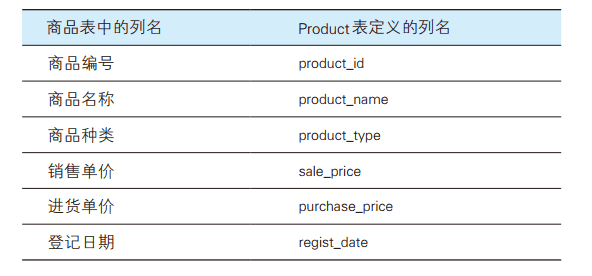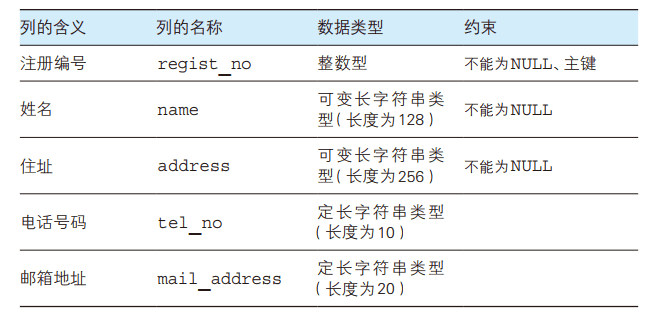catalogue
1, First knowledge database
1.1 types of DBMS
1.2 common system structure of RDBMS
1.3 database installation
1.3.1 introduction to Alibaba cloud MySQL server
1.3.2 introduction to building local MySQL environment
2, First knowledge of SQL
2.1 concept introduction
2.2 basic writing rules of SQL
2.3 creation of database (CREATE DATABASE statement)
2.4 table creation (CREATE TABLE statement)
Naming rules
2.6 designation of data type
2.7 setting of constraints
2.8 deletion and update of table
2.9 inserting data into the product table
3, Exercises
3.1
3.2
3.3
3.4
This chapter mainly introduces the database. Considering the ease of use and popularity, the course mainly uses MySql for introduction.
SQL training camp page address: AI training camp SQL - Alibaba cloud Tianchi
Tianchi Longzhu training camp address: AI training camp - Alibaba cloud Tianchi
1, First knowledge database
Database is a data set that can be accessed efficiently by saving a large amount of data and processing it by computer. This data set is called a database (DB). The computer system used to manage the database is called Database Management System (DBMS).
1.1 types of DBMS
DBMS is mainly classified by data storage format (type of database). At present, there are mainly the following five types
- Hierarchical Database (HDB)
- Relational Database (RDB)
This type of DBMS is called Relational Database Management System (RDBMS). There are five representative RDBMS.
* Oracle Database: Oracle RDBMS * SQL Server: Microsoft RDBMS * DB2: IBM Corporate RDBMS * PostgreSQL: GPl RDBMS * MySQL: GPl RDBMS
- Object Oriented Database (OODB)
- XML Database (XMLDB)
- Key value Store (KVS), for example: MongoDB
This course will introduce you to the operation method of database management system using SQL language, that is, relational database management system (RDBMS).
1.2 common system structure of RDBMS
When using RDBMS, the most common system structure is the client / server type (C/S type) (Figure 1-3)

1.3 database installation (must learn)
In this study, you can choose to use Alibaba cloud database server or install the database locally. The corresponding learning tutorial below also tells you how to create the database tables and data required for this study. Therefore, you must install the database in one way to complete the following study.
1.3.1 introduction to Alibaba cloud MySQL server
Save space, and write the specific introduction and pdf to you. You can click the link to view:
http://tianchi-media.oss-cn-beijing.aliyuncs.com/dragonball/SQL/other/ Introduction to Alibaba cloud MySQL server pdf
Advantages: easy operation and use, future trend (data on the cloud), convenient data import and export, and fast operation speed.
Disadvantages: you need to pay for it, but now there are preferential activities for developers. The basic version has 1 core and 1G, and the storage space is 20G. At present, the preferential price is only 9.9 yuan for half a year, and less than a cup of milk tea.
1.3.2 introduction to building local MySQL environment
Save space, and write the specific introduction and pdf to you. You can click the link to view:
http://tianchi-media.oss-cn-beijing.aliyuncs.com/dragonball/SQL/other/ Introduction to the construction method of local MySQL environment pdf
Advantages: free, enhance hands-on ability.
Disadvantages: installation and configuration are troublesome, and data import and export take a long time.
2, First knowledge of SQL
2.1 concept introduction

The table structure stored in the database is similar to the row and column in excel. In the database, the row is called a record, which is equivalent to a record, and the column is called a field, which represents the data items stored in the table.
The place where rows and columns meet is called a cell. Only one record can be entered in a cell.
SQL is a language developed for operating databases. The international organization for Standardization (ISO) has formulated corresponding standards for SQL. SQL based on this is called standard SQL (please refer to the column - standard SQL and specific SQL for relevant information).
There are few RDBMS based entirely on standard SQL. It is usually necessary to write specific SQL statements according to different RDBMS. In principle, this course introduces the writing method of standard SQL.
According to the different types of instructions given to RDBMS, SQL statements can be divided into the following three categories
DDL (Data Definition Language) is used to create or delete databases for storing data and tables and other objects in the database. DDL contains the following instructions.
-
CREATE: CREATE objects such as databases and tables
-
DROP: delete objects such as databases and tables
-
ALTER: modify the structure of objects such as databases and tables
DML (Data Manipulation Language) is used to query or change the records in the table. DML contains the following instructions.
-
SELECT: query the data in the table
-
INSERT: inserts new data into the table
-
UPDATE: UPDATE the data in the table
-
DELETE: DELETE the data in the table
DCL (Data Control Language) is used to confirm or cancel the changes to the data in the database. In addition, you can also set whether users of RDBMS have permission to operate objects (database tables, etc.) in the database. DCL contains the following instructions.
-
COMMIT: confirm the changes made to the data in the database
-
ROLLBACK: cancels changes to data in the database
-
GRANT: GRANT user operation permission
-
REVOKE: cancels the user's operation permission
90% of the SQL statements actually used belong to DML. This course will focus on DML.
2.2 basic writing rules of SQL
- SQL statement should be semicolon (;) ending
- SQL is not case sensitive for keywords, but the data inserted into the table is case sensitive
- The win system does not distinguish the case of table names and field names by default
- linux / mac strictly distinguishes the case of table names and field names by default
- This tutorial has uniformly adjusted the table name and field name to lowercase, so as to facilitate beginners to learn and use.
- The way constants are written is fixed
'abc', 1234, '26 Jan 2010', '10/01/26', '2010-01-26'...
- Words need to be separated by half width spaces or line breaks
Words in SQL statements need to be separated by half width spaces or line breaks, and full width spaces cannot be used as word separators, otherwise errors will occur and unexpected results will appear.
Please refer to Appendix 1 - SQL syntax specification carefully to develop standard writing habits.
2.3 creation of database (CREATE DATABASE statement)
Syntax:
CREATE DATABASE < Database name > ;
Create a database for this course
CREATE DATABASE shop;
2.4 table creation (CREATE TABLE statement)
Syntax:
CREATE TABLE < Table name > ( < Column name 1> < data type > < Constraints required for this column > , < Column name 2> < data type > < Constraints required for this column > , < Listing 3> < data type > < Constraints required for this column > , < Column name 4> < data type > < Constraints required for this column > , . . . < Constraint 1 of this table> , < Constraint 2 of this table> ,......);
Create the product list used in this course
CREATE TABLE product(
product_id CHAR(4) NOT NULL,
product_name VARCHAR(100) NOT NULL,
product_type VARCHAR(32) NOT NULL,
sale_price INTEGER,
purchase_price INTEGER,
regist_date DATE,
PRIMARY KEY(product_id)
) ;
Naming rules
- Only half width English letters, numbers and underscores () As the name of the database, table, and column
- The name must begin with a half width English letter
Table 1-3 correspondence between column names in the commodity table and the product table

2.6 designation of data type
For a table created in a database, all columns must specify a data type, and each column cannot store data that does not match the data type of the column.
Four basic data types
- INTEGER type
Used to specify the data type (numeric) of the column where integers are stored. Decimal numbers cannot be stored.
- CHAR type
It is used to store fixed length strings. When the length of the string stored in the column is less than the maximum length, half width spaces are used to supplement. It is generally not used because it will waste storage space.
- VARCHAR type
It is used to store variable length strings. Fixed length strings will be supplemented with half width spaces when the number of characters does not reach the maximum length, but variable length strings are different. Even if the number of characters does not reach the maximum length, half width spaces will not be supplemented.
- DATE type
The data type (date type) of the column used to specify the storage date (month, year, day).
2.7 setting of constraints
Constraint is the function of restricting or appending conditions to the data stored in the column in addition to the data type.
NOT NULL is a non NULL constraint, that is, the column must enter data.
PRIMARY KEY is a PRIMARY KEY constraint, which means that the column is a unique value. The data of a specific row can be retrieved through this column.
2.8 deletion and update of table
- Syntax for deleting tables:
DROP TABLE < Table name > ;
- Delete product table
It should be noted that the deleted table cannot be recovered and can only be reinserted. Please be very careful when deleting.
DROP TABLE product;
- ALTER TABLE statement to add columns
ALTER TABLE < Table name > ADD COLUMN < Definition of columns >;
- Add a list of products that can store 100 bit variable length strings_ name_ Pinyin column
ALTER TABLE product ADD COLUMN product_name_pinyin VARCHAR(100);
- Delete the ALTER TABLE statement for the column
ALTER TABLE < Table name > DROP COLUMN < Listing >;
- Delete product_name_pinyin column
ALTER TABLE product DROP COLUMN product_name_pinyin;
The ALTER TABLE statement, like the DROP TABLE statement, cannot be restored after execution. Mistakenly added columns can be deleted through the ALTER TABLE statement, or the tables can be deleted and recreated.
[extended content]
- Empty table contents
TRUNCATE TABLE TABLE_NAME;
Advantages: compared with drop``/``delete, truncate is the fastest when used to clear data.
- Update of data
Basic syntax:
UPDATE <Table name> SET <Listing> = <expression> [, <Column name 2>=<Expression 2>...]; WHERE <condition>; -- Optional, very important. ORDER BY clause; --Optional LIMIT clause; --Optional
When using update, pay attention to adding the where condition, otherwise all rows will be modified according to the statement
-- Modify all registration times UPDATE product SET regist_date = '2009-10-10'; -- Modify the unit price of some goods only UPDATE product SET sale_price = sale_price * 10 WHERE product_type = 'kitchenware';
Using UPDATE, you can also UPDATE the column to NULL (this UPDATE is commonly referred to as NULL emptying). At this time, you only need to write the value on the right of the assignment expression as NULL directly.
-- Update the registration date of the data (ball point pen) with commodity number 0008 to NULL UPDATE product SET regist_date = NULL WHERE product_id = '0008';
Like the INSERT statement, the UPDATE statement can also use NULL as a value.
**However, only columns without NOT NULL constraint and primary key constraint can be cleared to null** If the column with the above constraint set is updated to null, an error will occur, which is the same as the INSERT statement.
Multi column update
The SET clause of the UPDATE statement supports multiple columns as UPDATE objects at the same time.
-- Basic writing, one UPDATE Statement updates only one column UPDATE product SET sale_price = sale_price * 10 WHERE product_type = 'kitchenware'; UPDATE product SET purchase_price = purchase_price / 2 WHERE product_type = 'kitchenware';
This writing method can get the correct results, but the code is cumbersome. You can simplify the code by merging.
-- Combined writing
UPDATE product
SET sale_price = sale_price * 10,
purchase_price = purchase_price / 2
WHERE product_type = 'kitchenware';
It should be clear that the columns in the SET clause can be not only two columns, but also three columns or more.
2.9 inserting data into the product table
In order to learn the usage of INSERT statement, we first create a table named productins. The table creation statement is as follows:
CREATE TABLE productins (product_id CHAR(4) NOT NULL, product_name VARCHAR(100) NOT NULL, product_type VARCHAR(32) NOT NULL, sale_price INTEGER DEFAULT 0, purchase_price INTEGER , regist_date DATE , PRIMARY KEY (product_id));
Basic syntax:
INSERT INTO <Table name> (Column 1, Column 2, Column 3, ......) VALUES (Value 1, Value 2, Value 3, ......);
When performing full column INSERT on a table, you can omit the column list after the table name. VALUES are assigned to each column from left to right by default.
-- Include column list
INSERT INTO productins (product_id, product_name, product_type,
sale_price, purchase_price, regist_date) VALUES ('0005', 'pressure cooker', 'kitchenware', 6800, 5000, '2009-01-15');
-- Omit list
INSERT INTO productins
VALUES ('0005', 'pressure cooker', 'kitchenware', 6800, 5000, '2009-01-15');
In principle, executing the INSERT statement once will INSERT a row of data. When inserting multiple rows, you usually need to cycle through the INSERT statement a corresponding number of times. In fact, many RDBMS support inserting multiple rows of data at one time
-- Usual INSERT
INSERT INTO productins VALUES ('0002', 'Punch',
'Office Supplies', 500, 320, '2009-09-11');
INSERT INTO productins VALUES ('0003', 'motion T Shirt',
'clothes', 4000, 2800, NULL);
INSERT INTO productins VALUES ('0004', 'kitchen knife',
'kitchenware', 3000, 2800, '2009-09-20');
-- Multiline INSERT ( DB2,SQL,SQL Server, PostgreSQL and MySQL Multiline insert)
INSERT INTO productins VALUES ('0002', 'Punch',
'Office Supplies', 500, 320, '2009-09-11'),
('0003', 'motion T Shirt', 'clothes', 4000, 2800, NULL),
('0004', 'kitchen knife', 'kitchenware', 3000, 2800, '2009-09-20');
-- Oracle Multiple lines in INSERT
INSERT ALL INTO productins VALUES ('0002', 'Punch', 'Office Supplies', 500, 320, '2009-09-11')
INTO productins VALUES ('0003', 'motion T Shirt', 'clothes', 4000, 2800, NULL)
INTO productins VALUES ('0004', 'kitchen knife', 'kitchenware', 3000, 2800, '2009-09-20')
SELECT * FROM DUAL;
-- DUAL yes Oracle A temporary table that is unique (required for installation) A. So“ SELECT *FROM DUAL" Part is only temporary and has no practical significance.
When you want to assign a null value to a column in the INSERT statement, you can directly write null in the value list of the VALUES clause. The NOT NULL constraint must not be set for columns that want to INSERT null.
INSERT INTO productins (product_id, product_name, product_type,
sale_price, purchase_price, regist_date) VALUES ('0006', 'Fork',
'kitchenware', 500, NULL, '2009-09-20');
You can also insert DEFAULT values (initial values) into the table. You can set the DEFAULT value by setting the DEFAULT constraint in the CREATE TABLE statement that creates the table.
CREATE TABLE productins (product_id CHAR(4) NOT NULL, ((omitted) sale_price INTEGER ((omitted) DEFAULT 0, -- The default value of sales unit price is set to 0; PRIMARY KEY (product_id));
You can use the INSERT... SELECT statement to copy data from other tables.
-- Copy the data in the item table to the item table INSERT INTO productocpy (product_id, product_name, product_type, sale_price, purchase_price, regist_date) SELECT product_id, product_name, product_type, sale_price, purchase_price, regist_date FROM Product;
- This course uses tables to insert data sql as follows:
- DML : insert data
STARTTRANSACTION;
INSERT INTO product VALUES('0001', 'T shirt', 'clothes', 1000, 500, '2009-09-20');
INSERT INTO product VALUES('0002', 'Punch', 'Office Supplies', 500, 320, '2009-09-11');
INSERT INTO product VALUES('0003', 'motion T Shirt', 'clothes', 4000, 2800, NULL);
INSERT INTO product VALUES('0004', 'kitchen knife', 'kitchenware', 3000, 2800, '2009-09-20');
INSERT INTO product VALUES('0005', 'pressure cooker', 'kitchenware', 6800, 5000, '2009-01-15');
INSERT INTO product VALUES('0006', 'Fork', 'kitchenware', 500, NULL, '2009-09-20');
INSERT INTO product VALUES('0007', 'Dish cleaning board', 'kitchenware', 880, 790, '2008-04-28');
INSERT INTO product VALUES('0008', 'ball pen', 'Office Supplies', 100, NULL, '2009-11-11');
COMMIT;
3, Exercises
3.1
Write a CREATE TABLE statement to create a table Addressbook containing the items listed in table 1-A and set it as register_ Set the primary key constraint in the NO (registration number) column
Table 1-A columns in Addressbook

Result: create table addressbook(
-> regist_no int not null,
-> name varchar(128) not null,
-> address varchar(256) not null,
-> tel_no char(10) null,
-> mail_address char(20) null,
->PRIMARY KEY(regist_no)
-> );
3.2
Suppose you forgot to add the following column postal when creating the Addressbook table in Exercise 1.1_ Code, please add this column to the Addressbook table.
Column name: postal_code
Data type: fixed length string type (length is 8)
Constraint: cannot be NULL
Result: alter table addressbook add column post_ code char(8) not null;
3.3
Write an SQL statement to delete the Addressbook table.
Result: drop table Addressbook;
3.4
Write SQL statements to recover the deleted Addressbook table.
Result: the deleted table cannot be restored. You can use the create statement to recreate the table.